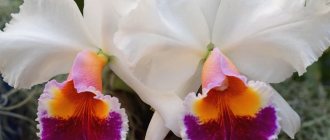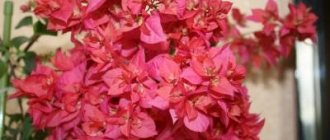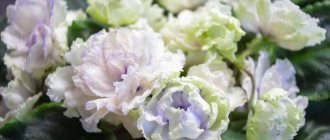Fragrance is not the most important advantage of orchids. But for some species and certain varieties, the smell is a significant addition to their main “image”. Favorite sweets, confectionery and spicy aromas, associated with the best desserts and delicacies, are not uncommon among orchids. Vanilla aromas or more original spices in the scent notes give the delightfully bright flowers even more exotic. And you can choose spicy fragrant orchids from both popular and rare species.
7 most fragrant orchids with a spicy scent
Classification of orchids by aroma
Orchids that have some kind of scent, whether pleasant or unpleasant, are less common than plants without a scent. In nature, this is far from the case, but among indoor species it is plants that are completely devoid of odor that dominate.
All orchids can be divided into three categories:
- species and varieties devoid or almost odourless;
- species and varieties with an unpleasant odor;
- species and varieties with a pleasant aroma - light, subtle or very bright, which divides this category into three subspecies :
- orchids, the smell of which can only be heard from a distance of less than 50 cm;
- varieties with an aroma that is noticeable a meter away from the plant;
- orchids with a strong scent that can be felt even from a distance of more than 3 m.
Orchids do not always reveal their scent right away and often do not smell at the most predictable times. Some varieties are similar to any tropical flowering crops and smell pleasant, especially in the dark. Others - only in the evening, others - at dawn and in the morning, and there are also those whose aroma does not change throughout the day.
History of origin
Delicacy of flowers, a long flowering period, these and other features are inherent in this hybrid. In 1982, the American plant officially registered this type of orchid under the name Phalenopsis Sweet Memory, whose author is considered to be Rex Smith. Later in the 90s, the plant received the currently used name Phalaenopsis Liodoro.
Phalaenopsis Devertiana and Violacea were used as “parents” for crossing.
Reference . In nature, the ancestors of this species can be found on trees and between stones in the tropical forests of Malaysia, and Phalaenopsis Violacea can also be found on the northern coast of Australia and China.
Cymbidium swordifolia
Cymbidium ensifolium is the honeyiest of all orchids and the most popular of the cymbidiums. This is a very graceful orchid of the sympodial type with poorly developed centimeter-long pseudobulbs, completely covered with leaf sheaths, and long roots. Narrow lanceolate leaves from 30 cm to 1 m in length seem stunningly straight and strict, not only due to their folded structure, but also to their very dark color.
Cymbidium ensifolium. © 阿橋HQ
Vertical inflorescences are usually somewhat shorter than the leaves. They bear up to 9 flowers that last for several weeks. With a diameter of 3 to 5 cm, they flaunt beige-yellowish sepals and petals with longitudinal, reddish veins, and sometimes spots, and a greenish lip covered with patterns.
Cycnoches pentadactylon
Cychnoches pentadactylon surprises anyone with its chocolate and amazingly delicious aroma, which is characterized by soft vanilla overtones. This is a very rare orchid, the flowers of which can’t help but evoke associations with miniature dragons. And it is even more surprising that in culture, cyknotes are surprisingly unpretentious and are more similar to phalaenopsis than to rare species.
Cychnoches pentadactylon. © Gena Jogolev
The bizarre, fleshy, round-spindle-shaped pseudobulbs of this sympodial orchid surprise with their numerous internodes and produce tightly hugging the stem, thin, oval-lanceolate leaves with a pointed tip, from the axils of which grows a short peduncle with 30 or slightly less elegant flowers with a diameter of up to 10 cm Oval, with a narrowed base, petals and sepals turned back, and a thin lip fancifully arched create a shape that truly resembles a tailed dragon in flight.
Rhynhostilis gigantea
Giant rhynchostylis (Rhynchostylis gigantea) is the best of the orchids with “Christmas” spicy aromas, the complex trails of which you want to unravel endlessly, barely catching the light undertones of cloves, cinnamon, nutmeg, coriander, mixed with a sweet honey cloying.
Giant Rhynchostylis (Rhynchostylis gigantea). © Maja Dumat
This is a very large orchid with narrow but fleshy leaves, up to 40 cm in length, growing in two rows, hanging fancifully with age, with an increasingly woody and tall stem and short peduncles. Dense cylindrical panicles of several dozen flowers seem strikingly massive.
Despite the fact that the flowers do not exceed 2.5 cm in diameter, they are very beautiful - with a spur, petals and sepals narrowed at the base, giving the flower airiness, and a three-lobed lip. White or purple, the flowers are clearly visible and seem very delicate.
Hybrid
Crossing phalaenopsis is not one of the most labor-intensive processes in botany, so industrial cultivation is reaching new heights in the cultivation of this genus of orchids. Hybrids are divided into several categories, depending on the size of the flower and the type of flowering.
Miniature (Phal. Mini Mark “Maria Teresa”)
- A striking representative is mini phalaenopsis. They are very convenient to keep at home or in the office; they do not take up much space.
- Fragile graceful flowers are painted in different shades, from light pink to rich tones.
Taiwanese (Amboinensis, Venosa, Violacea)
- Unlike miniature, discreet flowers, orchids of this group are strewn with large flowers of exotic colors.
A distinctive feature is the unusual colors, the sharp contrast between the petals and the lip. - The unpretentiousness of plants was also included by botanists in this section of hybrids.
Novelty Group
This group includes: Prefection In "Chen", l-Hsin Spot Eagle "Montclair", Nobby's Pacific Sunset "Red Pearl", Brother Pirate King "Sapphire Dragon", Misty Pride "CR".
- The uniqueness of the group is that after finishing flowering, the plant goes into a resting phase. Then the peduncle comes to life, and by the new flowering period new buds appear from its top.
- An orchid produces two or more flower stalks at once.
- Another distinctive feature of Novelty hybrids are specks, strokes, veins and other patterns on the petals.
In addition to the above varieties and hybrids, phalaenopsis also deserve the attention of the gardener: Big Lip, Wild Cat, Liodoro and Multiflora.
Zygopetalum
Zygopetalum is one of the orchids whose spicy aroma is easily recognizable and resembles a freshly ground mixture of peppers, superimposed on a base of lilac aroma. The fragrant flowers of zygopetalums emit a spicy scent only in the first half of the day. This is one of the most easily recognizable orchids with large pseudobulbs (up to 7 cm), thick whitish roots and long, folded, spectacularly shiny and not very hard lanceolate leaves.
Zygopetalum. © Birgit Carlsson
Zygopetalums are famous for their shade tolerance, abundance of half-meter leaves, making a very bright impression. But most of all - the unique palette of flower colors. Small, oval-drop-shaped sepals and petals with spots and stripes on a yellow-green background highlight the beauty of the huge, wavy spatulate lip with violet, lilac and blue patterns or colors.
The color shades of zygopetalum flowers are often compared to Saintpaulias. And the fact that each peduncle is capable of producing up to 12 flowers only enhances the attractiveness of zygopetallums.
Perfume factory: 7 favorites on your windowsill
Mass markets are unlikely to please you with exquisite varieties. You can purchase phalaenopsis with a refined scent in a specialized nursery or online store. We recommend taking a closer look at the following varieties:
"Scention"
The orchid belongs to the multiflora type, that is, it has the ability to grow in height during the flowering period, forming new buds. Peach-colored petals with a lilac haze along the bottom edge exude a citrus aroma. The color of the leaves is mesmerizing - emerald, with many dark inclusions. The smell is present both day and night. It becomes especially pronounced in the evening.
READ 10 types of orchids that are striking in their beauty: recommendations for care and cultivation
"Odorion"
The Odorion
Phalaenopsis orchid delights the eye with buds of rich pastel shades - peach, pink, powder or orange-raspberry. The aroma cannot be clearly divided into components. Overall it can be described as a floral perfume with notes of jasmine and citrus. The plant likes to be under bright, diffused light for up to 16 hours a day.
"Diffusion"
It is distinguished by particularly lush flowering. With proper care, 'Diffusion' will produce many buds from spring to fall. It has an unusual smell: at first it is weightless, almost inaudible, and in the evening it reveals notes of ginger and warm citrus. The intensity of the aroma depends on external factors (humidity, temperature and lighting). The flowers have a light crimson color with a noble lilac depth.
"Dusty Belle"
Dusty Belle
Phalaenopsis orchid with pink petals and purple-orange lip filling. Sensual beauty BeIIe! It smells fragrant throughout the day. The smell is incomparable: on the one hand, it is the clear sound of ylang-ylang oil, sandalwood, musk, peach, and on the other hand, a pharmaceutical medicine. This composition evokes mixed feelings, especially since the aroma is quite strong. The plant loves moist air and temperature changes - 26-27 degrees during the day and 18-19 at night.
"Valkion"
Orchid Valkion
is practically no different from the “Scention” variety: flowers of pastel shades smell of citrus with notes of lily of the valley. In Russia, these phalaenopsis are classified as a separate group, and, for example, in Holland “Scention” and “Valkion” are identical species of orchids.
"Orange"
Orchid Orange
Sugar peach in the world of exotic flowers! The buds are colored orange and exude the scents of vanilla, honey, chocolate and buttercream. In the morning the aroma reveals bright notes of lilac and hyacinth, and in the evening it reveals tart sweetness. If you provide the plant with access to sunlight (but not the scorching sun!), the fragrance will be more intense.
"Middenrose"
Orchid Miden Rose
Ardent Lady with bright crimson petals and a throat edged with yellow. The aroma is not simple, it reveals itself gradually: spicy anise gives way to notes of warm lemon-ginger pie. Flowers of the Middenrose variety do not tolerate direct sunlight, so on a hot day the window with the plant is shaded.
READ 7 ways to propagate orchids at home. Basic mistakes and ways to avoid them.
Arachnis
Arachnis orchid has no less original flowering and unique aromas. This orchid has long stems and rigid, belt-shaped leaves arranged in two rows. Peduncles can stretch up to more than a meter. They grow from the axils of the leaves, bending bizarrely.
Arachnis. © Tjflex2
The huge flowers, up to 12 cm in diameter, do not seem massive: they are beige-yellow, with small dark speckles, spider-like, with a waxy texture; they stay on the peduncles for an amazingly long time.
The petals and sepals are narrow, with curved and flared rounded ends, and the lip with a wide spur is decorated with stripes or plain. The flower resembles a spider, which is how the plant got its name. The aromas of this orchid are not always the strongest, but unique: musky, almond, anise, fennel - all these shades are inimitable.
About hybrids, names and descriptions
Breeders began refining the genus almost immediately as soon as they received several original plants. As a result, the first hybrid was produced in 1875. The famous botanist John Seden crossed the Aphrodite phalaenopsis with the Ecumenical species. At first he did not produce flowers, and the first buds were obtained after painstaking work on improvement, which lasted almost 11 years.
By the beginning of the 20th century, there were already 13 artificially bred varieties. The first truly interesting hybrid was created in 1940. It was named Doris (Phalaenopsis Doris). This species is distinguished by large snow-white flowers, whose diameter is 140 mm.
Maria Teresa is particularly charming . The plant grows only up to 25 cm, but produces many flower stalks with a large number of small cream buds, whose petals are decorated with small crimson-golden specks.
Among the spotted phalaenopsis, it is worth highlighting the hybrid Paradise . This brainchild of French breeders blooms medium-sized flowers with oblong yellowish-green petals covered with pink-chocolate spots.
Having exhausted all the possibilities of intrageneric crossing, scientists began to hybridize phalaenopsis with other orchids of similar origin. The first fruit of their efforts was Doritaenopsis . The variety appeared in 1923 - it was distinguished by the bright scarlet color of its buds. Further work led to the appearance of plants with orange, purple, and burgundy petals.
A very remarkable hybrid Lip , which we call (due to the striking resemblance of the buds to graceful winged insects) “Butterfly”. The native name means “Big Lip” - and it’s true that in representatives of this variety the lower petal is noticeably hypertrophied and widely spread. The buds themselves are very delicate and large - the diameter is 100 mm. Shades range from milky to purple. Some varieties are variegated.
Nowadays, there are thousands of hybrids, many of which bear very little resemblance to the “purebred” representatives of the genus in question. You can find out more about the most interesting of them on the pages of our website.
The diversity of phalaenopsis makes them welcome guests in the homes of flower lovers. These orchids are not capricious, and therefore maintenance usually does not cause any particular difficulties.
Katasetum
Fans of confectionery art will easily recognize the smells of Catasetum - rare orchids whose flowers smell of freshly baked rye bread and malt muffins. These are sympodial orchids with oval pseudobulbs very tightly pressed together, much like cigars with a pointed end (they can grow up to 20 cm in length).
Catasetum. © Sylvio Rodrigues Pereira
Even during the dormant period, only young pseudobulbs are leafy; from the second year, lanceolate leathery leaves with longitudinal veins fall off. This deciduous orchid simultaneously produces large male flowers, up to 12 cm in diameter, and small female flowers.
Only the first ones can boast of high decorativeness - turned upside down, with a funnel-shaped lip, oval sepals and petals. The unique dark red, chocolate colors contrasting with the yellow and green lip only highlight how unusual this orchid is.
Wanda
Vanda are also associated with spices , although they vary greatly in intensity and sometimes take on shades of grape. The brightest orchid with rounded petals has become famous both for its dazzling “acrylic” shades of purple, pink, lilac, violet, and for its complex character.
Vanda. © annatomic8
Vandas are monopodial orchids that do not form pseudobulbs. Medium stems with densely sessile, strap-shaped and brightly colored leaves and greenish aerial roots create very bizarre silhouettes.
Few-flowered or multi-flowered vandas always look bright. On peduncles of various shapes, developing from the axils of the leaves, from 2 to 15 flowers bloom, which gradually grow and acquire characteristic colors (only a few days after blooming). Vanda flowers can exceed 15 cm in diameter; the rounded lines are their main feature.
How to propagate?
Flower growers distinguish two methods of propagating this plant:
- Dropping off children . After the baby appears on the orchid, it should be sprayed more often. When the baby has roots, it must be carefully cut off, treating the cuts with crushed charcoal, planted in a separate container and provided with proper care.
- Vegetative . The roots should be divided into several parts, taking into account that each part will have at least two bulbs, and planted in prepared pots. The separation areas also need to be treated with crushed charcoal. You need to care for such seedlings in the same way as an adult flower.











